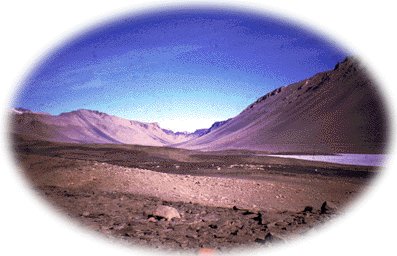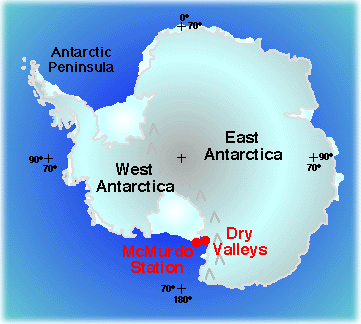
|


In 1996 I was lucky enough to be selected as a parcticipant in the Teachers Experiencing Antarctica (TEA) program sponsored by the national Science Foundation, Education and Human Resources Directorate; Division of Elementary, Secondary and Informal Education in collaboration with the Office of Polar Programs. I was assigned to Dr. Robert Wharton, PI of the Long Term Ecological Research (LTER) program in the dry valley mountains of Antarctica. (Check out their web site at http://lternet.edu/) The LTER network of more than 20 research sites around the country and several sites in other countries, is funded for a potential of 4 six year cycles so that data can be collected during a long enough period of time to detect changes and answer long term research questions. Our work took place in the Taylor Valley at the Lake Hoare field camp where we worked with the most pristine watershed on the planet. During the 1999 - 2000 field season, I again journeyed to the ICE to work on a similar research project to study the dry valley watershed and to collaborate with students from both Lakeside Upper School in Seattle and the Tuscaloosa Academy in Tuscaloosa Alabama. During this field season I also worked to network Antarctic support employees with teachers and classes from all over the country. I had the opportunity to interview several PI scientists who shared their work with my program. On the TEA web site, you can find those journal entries and accompanying photos. To read about this research, see the following web site:tea_previousteachers.html
For the coming field season 2002 - 2003, I have the privilege to join the team of Dr. Laurie Connell and Dr. Russell Rodriguez. The National Science Foundation, Office of Polar Programs, Division of Antarctic Biology and Medicine fund this proposed research. The following explains our plans:
Antarctica is among the coldest, driest, windiest places on earth. The McMurdo Dry Valley mountains are located 76 degrees 30 minutes to 78 degrees 30 minutes South, 16 degrees to 164 degrees East and about 60 kilometers from the town of McMurdo Station. The valleys make up much of the less than 2% of land that is ice free in Antarctica. Along the floor of the valleys are perennially ice-covered lakes. The Taylor Valley is the site of the first year of our research. The valleys are considered a polar desert with an average annual temperature of -20 degrees Celsius and 6 cm of precipitation per year. This environment is considered to be among the most extreme place where life can exist with strong winds blowing down the valley from the ice cap. The valley is bordered on both sides by high mountains with icefalls flowing between them from the polar ice cap. There is a series of lakes on the valley floor and rocky soils from the shoreline up to the solid rock of the mountain. Ecological communities of organisms live in the lakes and in the soils. This research project will look at the community of life living in the soils asking research questions about the role played by yeast, one of the few endemic, or native organism in Antarctica. The soils in the valleys vary as to salinity concentrations and pH with some soils being very alkaline. Some soils contain ancient concentrations of organic nutrients from times before the ice age. Modern organisms may use these nutrients to survive. Some communities of organisms do exist in spite of low primary productivity The following is taken from the summary of the project written by Dr. Connell: The soil community of Antarctic polar desert is composed of few endemic species of bacteria, fungi and invertebrates. Both filamentous and single cellular fungi have been isolated from a variety of Antarctic soil types, but only yeast appear to be endemic to the polar desert soils. Although the ecological roles of yeast in Antarctic soils are undefined, yeast may be the principal taxa available in the heterotrophic communities to synthesize sterols required by soil invertebrates. In addition, yeast may be involved in accumulating and mobilizing growth limiting nutrients such as phosphorus into the polar desert food web. Industrial and agricultural yeasts have been well described, however, not much is known about their ecological roles. This proposed multidisciplinary research collaboration will characterize the roles of yeast in the McMurdo Dry Valley ecosystem in order to better understand polar deserts and other extreme environments, as well as provide a foundation for incorporating yeast into biogeochemical models of temperate environments. Soil microbiota mediate most of the terrestrial ecosystem processes such as decomposition, soil respiration, the uptake and fixation of micro and macro-nutrients, detoxification of heavy metals, and serve as major global carbon sinks. The complexity of soil communities in temperate regions pose difficulties in studying the relationships between biotic and abiotic parameters of ecosystem function and the factors controlling populations of soil microbiota remain poorly understood. The extreme climate and relatively simple community structure of the continental Antarctic desert regions offer a unique opportunity to define interactions between soil organisms that are central to many ecosystems processes. To start the exploration of the ecological roles of yeast in the polar desert, their abundance and distribution will be correlated with physical and chemical soil properties. These data will be stored and analyzed using Geographic Information Systems (GIS) layers that will be placed into the existing McMurdo Dry Valley coverage. Several physiological parameters will e explored in vitro to develop a basis for understanding the functional role(s) yeast may play. Sterols synthesized by McMurdo Dry Valley soil yeasts, as well as the ability of these yeasts to survive multiple freeze-thaw cycles, will be studied and explained. The capacity of indigenous Antarctic yeast to utilize, compete for and store phosphorus will be ascertained. The evolution of Dry Valley yeast will be addressed by determining intra-and inter valley population relatedness patterns, based on DNA sequences. These experiments will form a strong foundation for future investigations. The hypotheses being explored in this research are as follows:
This project will provide additional opportunities for collaborative research. Both soil samples and extracted DNA will be shared with other interested labs and schools. Students are encouraged to think about ecosystems and the complex interactions of the various biotic and abiotic factors. The Antarctic Dry Valley soil ecosystem is probably the simplest on earth.
|






